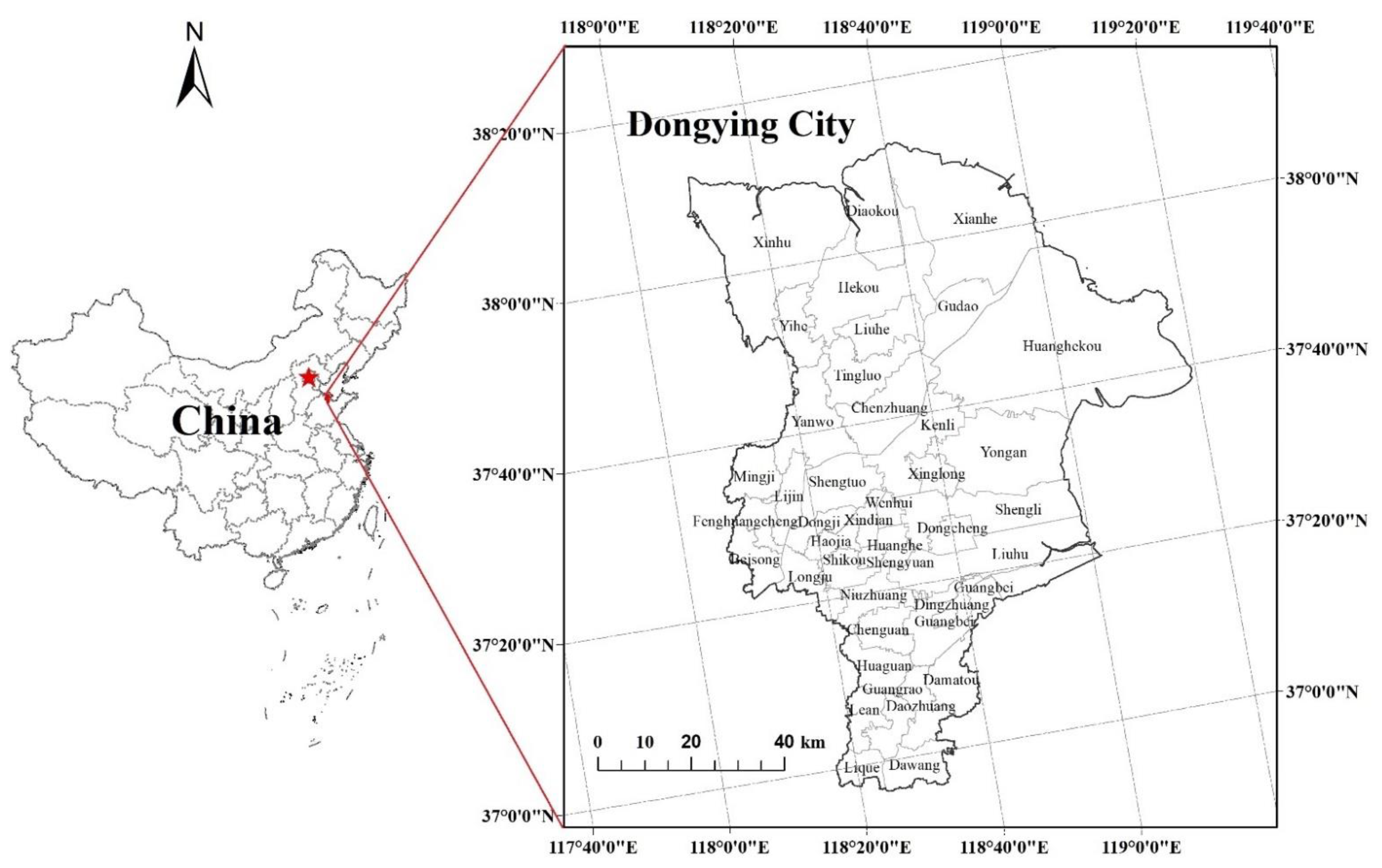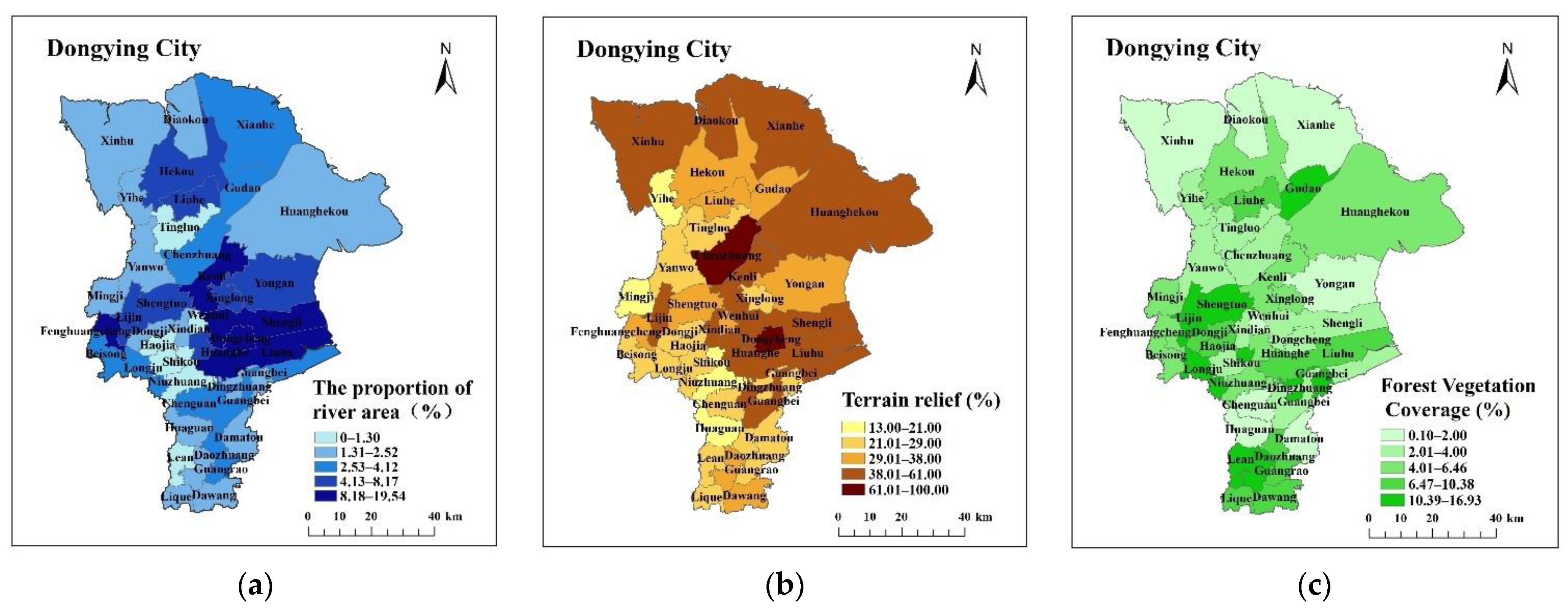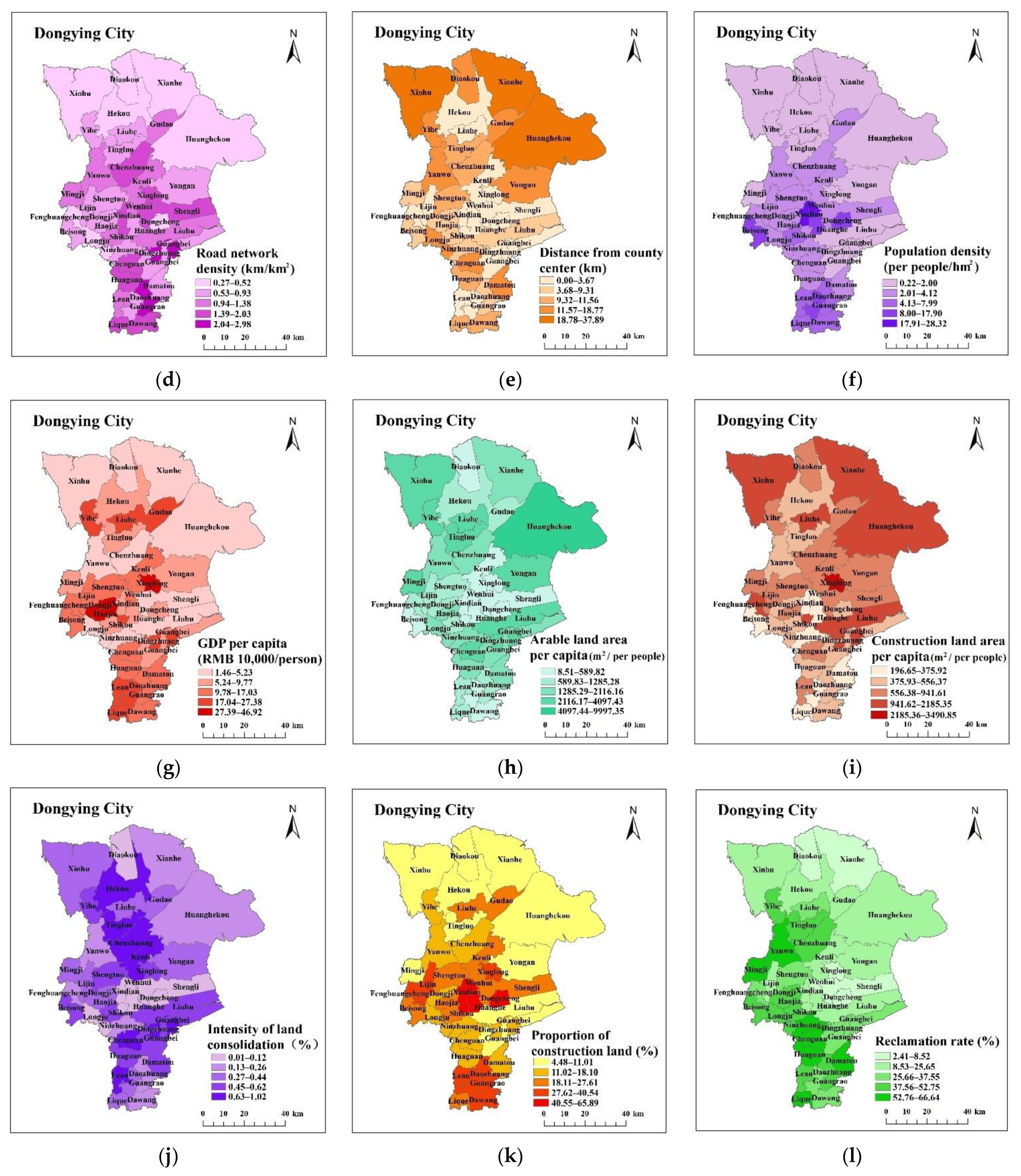Functional Zoning and Path Selection of Land Comprehensive Consolidation Based on Grey Constellation Clustering: A Case Study of Dongying City, China
Abstract
:1. Introduction
2. Methodology
2.1. Study Area and Data Source
2.2. Analysis Methods
2.2.1. Construction of Evaluation Index System of Land Renovation District
2.2.2. Determination of Indicator Weights and Constellation Cluster Analysis
Calculation of Indicator Weights
- (1)
- Data normalization
- (2)
- Calculate the proportion Pij of the ith township to the index of the jth index
- (3)
- Calculate the entropy value ej of the jth index
- (4)
- Calculate the information entropy redundancy
- (5)
- Calculate the weight of each indicator
Constellation Cluster Analysis
- (1)
- Data transformation
- (2)
- Assign value to the selected indicator
- (3)
- Calculate the coordinate value of each sample point (township)
- (4)
- Draw a constellation diagram
- (5)
- Calculate the comprehensive index value
3. Results and Discussion
3.1. Functional Zoning Results of Comprehensive Land Consolidation
3.2. Adjustment and Verification of Clustering Results
3.3. Clustering Results and Consolidation Path Selection
4. Conclusions
Author Contributions
Funding
Institutional Review Board Statement
Informed Consent Statement
Data Availability Statement
Conflicts of Interest
References
- Yu, Z.; Xu, E.; Zhang, H.; Shang, E. Spatio-Temporal Coordination and Conflict of Production-Living-Ecology Land Functions in the Beijing-Tianjin-Hebei Region, China. Land 2020, 9, 170. [Google Scholar] [CrossRef]
- Adams, E.A.; Kuusaana, E.D.; Ahmed, A.; Campion, B.B. Land dispossessions and water appropriations: Political ecology of land and water grabs in Ghana. Land Use Policy 2019, 87, 104068. [Google Scholar] [CrossRef]
- Wójcik-Leń, J.; Sobolewska-Mikulska, K.; Sajnóg, N.; Leń, P. The idea of rational management of problematic agricultural areas in the course of land consolidation. Land Use Policy 2018, 78, 36–45. [Google Scholar] [CrossRef]
- Yang, X.; Bai, Y.; Che, L.; Qiao, F.; Xie, L. Incorporating ecological constraints into urban growth boundaries: A case study of ecologically fragile areas in the Upper Yellow River. Ecol. Indic. 2021, 124, 107436. [Google Scholar] [CrossRef]
- Amponsah, O.; Blija, D.K.; Ayambire, R.A.; Takyi, S.A.; Mensah, H.; Braimah, I. Global urban sprawl containment strategies and their implications for rapidly urbanising cities in Ghana. Land Use Policy 2022, 114, 105979. [Google Scholar] [CrossRef]
- Zhang, X.; Timo De Vries, W.; Li, G.; Ye, Y.; Zhang, L.; Huang, H.; Wu, J. The suitability and sustainability of governance structures in land consolidation under institutional change: A comparative case study. J. Rural Stud. 2021, 87, 276–291. [Google Scholar] [CrossRef]
- Bahar, S.K.; Kirmikil, M. The evaluation of agricultural landowner inputs before and after land consolidation: The Kesik Village example. Land Use Policy 2021, 109, 105605. [Google Scholar] [CrossRef]
- Janus, J.; Ertunç, E. Differences in the effectiveness of land consolidation projects in various countries and their causes: Examples of Poland and Turkey. Land Use Policy 2021, 108, 105542. [Google Scholar] [CrossRef]
- Sagaydak, A.; Sagaydak, A. Agricultural land consolidation vs. land fragmentation in russia. Int. J. Eng. Geosci. 2021, 7, 128–141. [Google Scholar] [CrossRef]
- Nguyen, H.Q.; Warr, P. Land consolidation as technical change: Economic impacts in rural Vietnam. World Dev. 2020, 127, 104750. [Google Scholar] [CrossRef]
- Rybicki, R. Environmental Effects of Reducing Land Fragmentation in Land Consolidation at West Roztocze at the Slope Scale. J. Ecol. Eng. 2021, 22, 241–249. [Google Scholar] [CrossRef]
- Balawejder, M.; Matkowska, K.; Rymarczyk, E. Effects of land consolidation in Southern Poland. Acta Sci. Pol. Adm. Locorum 2021, 20, 269–282. [Google Scholar] [CrossRef]
- Postek, P.; Leń, P.; Stręk, Ż. The proposed indicator of fragmentation of agricultural land. Ecol. Indic. 2019, 103, 581–588. [Google Scholar] [CrossRef]
- Liu, J.; Jin, X.; Xu, W.; Sun, R.; Han, B.; Yang, X.; Gu, Z.; Xu, C.; Sui, X.; Zhou, Y. Influential factors and classification of cultivated land fragmentation, and implications for future land consolidation: A case study of Jiangsu Province in eastern China. Land Use Policy 2019, 88, 104185. [Google Scholar] [CrossRef]
- Muleta, T.T.; Biru, M.K. Human modified landscape structure and its implication on ecosystem services at Guder watershed in Ethiopia. Environ. Monit. Assess. 2019, 191, 295. [Google Scholar] [CrossRef]
- Nguyen, T.H.T.; Thai, T.Q.N.; Tran, V.T.; Pham, T.P.; Doan, Q.C.; Vu, K.H.; Doan, H.G.; Bui, Q.T. Land Consolidation at the Household Level in the Red River Delta, Vietnam. Land 2020, 9, 196. [Google Scholar] [CrossRef]
- Demetriou, D.; Stillwell, J.; See, L. Land consolidation in Cyprus: Why is an Integrated Planning and Decision Support System required? Land Use Policy 2012, 29, 131–142. [Google Scholar] [CrossRef]
- Asiama, K.O.; Bennett, R.M.; Zevenbergen, J.A. Land consolidation on Ghana’s rural customary lands: Drawing from The Dutch, Lithuanian and Rwandan experiences. J. Rural Stud. 2017, 56, 87–99. [Google Scholar] [CrossRef]
- Zhou, J.; Cao, X. What is the policy improvement of China’s land consolidation? Evidence from completed land consolidation projects in Shaanxi Province. Land Use Policy 2020, 99, 104847. [Google Scholar] [CrossRef]
- Xiao, P.; Zhao, C.; Zhou, Y.; Feng, H.; Li, X.; Jiang, J. Study on Land Consolidation Zoning in Hubei Province Based on the Coupling of Neural Network and Cluster Analysis. Land 2021, 10, 756. [Google Scholar] [CrossRef]
- Lee, T.; Lee, B.; Su, Y.; Chang, H. Are There Any Undesired Effects of Anti-Land Fragmentation Programs on Farm Production Practices and Farm Input Use? Land 2021, 10, 138. [Google Scholar] [CrossRef]
- Bijandi, M.; Karimi, M.; van der Knaap, W.; Farhadi Bansouleh, B. A novel approach for multi-stakeholder agricultural land reallocation using agent-based modeling: A case study in Iran. Landsc. Urban. Plan. 2021, 215, 104231. [Google Scholar] [CrossRef]
- Thapa, G.B.; Niroula, G.S. Alternative options of land consolidation in the mountains of Nepal: An analysis based on stakeholders’ opinions. Land Use Policy 2008, 25, 338–350. [Google Scholar] [CrossRef]
- de Vries, W.T. Social Aspects in Land Consolidation Processes. Land 2022, 11, 452. [Google Scholar] [CrossRef]
- Guo, B.; Fang, Y.; Jin, X.; Zhou, Y. Monitoring the effects of land consolidation on the ecological environmental quality based on remote sensing: A case study of Chaohu Lake Basin, China. Land Use Policy 2020, 95, 104569. [Google Scholar] [CrossRef]
- Li, X.; Hui, N.; Yang, Y.; Ma, J.; Luo, Z.; Chen, F. Short-term effects of land consolidation of dryland-to-paddy conversion on soil CO2 flux. J. Environ. Manag. 2021, 292, 112691. [Google Scholar] [CrossRef]
- Dumbrovský, M.; Sobotková, V.; Šarapatka, B.; Váchalová, R.; Pavelková Chmelová, R.; Váchal, J. Long-term improvement in surface water quality after land consolidation in a drinking water reservoir catchment. Soil Water Res. 2016, 10, 49–55. [Google Scholar] [CrossRef] [Green Version]
- Koshiyama, N. Influence of Field Water Management by Land Consolidation in Paddy Field Zone in Hokkaido, Japan. Irrig. Drain. 2019, 68, 103–108. [Google Scholar] [CrossRef]
- Chen, X.; Lin, C.; Hou, X.; Wu, Z.; Yan, G.; Zhu, C. The impact of land consolidation on arable land productivity: A differentiated view of soil and vegetation productivity. Agric. Ecosyst. Environ. 2022, 326, 107781. [Google Scholar] [CrossRef]
- Burger, J.; Gochfeld, M. Initiating events, functional remediation, and assessment of risk to ecological resources. Ecol. Indic. 2016, 71, 32–40. [Google Scholar] [CrossRef] [Green Version]
- Abubakari, Z.; van der Molen, P.; Bennett, R.M.; Kuusaana, E.D. Land consolidation, customary lands, and Ghana’s Northern Savannah Ecological Zone: An evaluation of the possibilities and pitfalls. Land Use Policy 2016, 54, 386–398. [Google Scholar] [CrossRef]
- Kirmikil, M.; Arici, I. The use of landscape metrics to assess parcel conditions pre- and post-land consolidation. J. Food Agric. Environ. 2013, 11, 985–989. [Google Scholar]
- Kupidura, A.; Łuczewski, M.; Home, R.; Kupidura, P. Public perceptions of rural landscapes in land consolidation procedures in Poland. Land Use Policy 2014, 39, 313–319. [Google Scholar] [CrossRef]
- Pašakarnis, G.; Maliene, V.; Dixon-Gough, R.; Malys, N. Decision support framework to rank and prioritise the potential land areas for comprehensive land consolidation. Land Use Policy 2021, 100, 104908. [Google Scholar] [CrossRef]
- Xia, M.; Wang, L.; Wen, B.; Zou, W.; Ou, W.; Qu, Z. Land Consolidation Zoning in Coastal Tidal Areas Based on Landscape Security Pattern: A Case Study of Dafeng District, Yancheng, Jiangsu Province, China. Land 2021, 10, 145. [Google Scholar] [CrossRef]
- Wu, C.; Huang, J.; Zhu, H.; Zhang, L.; Minasny, B.; Marchant, B.P.; McBratney, A.B. Spatial changes in soil chemical properties in an agricultural zone in southeastern China due to land consolidation. Soil Tillage Res. 2019, 187, 152–160. [Google Scholar] [CrossRef]
- Shan, W.; Jin, X.; Ren, J.; Wang, Y.; Xu, Z.; Fan, Y.; Gu, Z.; Hong, C.; Lin, J.; Zhou, Y. Ecological environment quality assessment based on remote sensing data for land consolidation. J. Clean. Prod. 2019, 239, 118126. [Google Scholar] [CrossRef]
- Wang, Y.; Li, Y. Promotion of degraded land consolidation to rural poverty alleviation in the agro-pastoral transition zone of northern China. Land Use Policy 2019, 88, 104114. [Google Scholar] [CrossRef]
- Basistaa, I.; Balawejder, M. Assessment of selected land consolidation in south-eastern Poland. Land Use Policy 2020, 99, 105033. [Google Scholar] [CrossRef]
- Cropper, W.H. Rudolf Clausius and the road to entropy. Am. J. Phys. 1998, 54, 1068–1074. [Google Scholar] [CrossRef]
- Peng, D.M.; Mu, Y.T. Predicting the Production of the World’s Cephalopod Fisheries by Means of Differences in Level of Development and Production Trends. Trans. Am. Fish. Soc. 2019, 148, 260–270. [Google Scholar] [CrossRef]
- Xuejiao, L.; Wu, X.; Sucui, L.; Qiyuan, W.; Chunmeng, Z.; Miaomiao, Z. Land reclamation zoning of Chaohu River Basin Based on GIS and Grey Constellation Clustering. Trans. Chin. Soc. Agric. Eng. 2018, 34, 253–262. [Google Scholar]
- Kubacka, M.; Ywica, P.; Subirós, J.V.; Bródka, S.; Macias, A. How do the surrounding areas of national parks work in the context of landscape fragmentation? a case study of 159 protected areas selected in 11 eu countries. Land Use Policy 2022, 113, 105910. [Google Scholar] [CrossRef]
- Lisec, A.; Primožič, T.; Ferlan, M.; Šumrada, R.; Drobne, S. Land owners’ perception of land consolidation and their satisfaction with the results—Slovenian experiences. Land Use Policy 2014, 38, 550–563. [Google Scholar] [CrossRef]
- Nomura, H.; Yabe, M.; Nishio, T.; Izumi, M.; Hirai, K.; Kurokawa, T. Framework for improvement of farmland biodiversity in Japan. J. Environ. Plan. Manag. 2013, 56, 743–758. [Google Scholar] [CrossRef]
- Wood, S.L.; Rhemtulla, J.M.; Coomes, O.T. Cropping history trumps fallow duration in long-term soil and vegetation dynamics of shifting cultivation systems. Ecol. Appl. 2017, 27, 519–531. [Google Scholar] [CrossRef]





| Indicator Category | Meta-Metric | Indicator Calculation Formula | Indicator Meaning | Indicator Properties |
|---|---|---|---|---|
| Natural properties | The proportion of river area | Area of watershed within township/area of each township | Reflects the amount of water contained in each township, and indirectly reflects the irrigation situation of cultivated land. | Positive |
| Terrain relief | Extract slope map from DEM | Reflects the topography of each township | Negative | |
| Forest Vegetation Coverage | Woodland area of each township/area of each township | Reflects the ecological environment construction of each township | Negative | |
| Location attribute | Road network density | Length of roads at all levels in each township/area of each township | Reflects the convenience of road traffic in each township | Positive |
| Distance from county center | The distance from the center of each township to the center of the county | Reflects the distance between each township and the county center | Negative | |
| Socioeconomic attributes | Population density | Total population of each township/area of each township | Reflects the degree of intensive and economical use of land in each township | Positive |
| GDP per capita | Average annual income of each township/total population of each township | Reflects the socio-economic level of each township | Positive | |
| Arable land area per capita | Area of arable land in each township/total population of each township | The comparative relationship between population and cultivated land is used to illustrate the scarcity of cultivated land resources | Positive | |
| Construction land area per capita | Construction land area of each township/total population of each township | Reflects the land-use situation of each township residential area | Positive | |
| Land-use attributes | Intensity of land consolidation | Newly-added cultivated land area of each township/area of each township | Reflects the status quo of the number of agricultural land remediation in each township | Positive |
| Proportion of construction land | Construction land area of each township/area of each township | Reflects the overall pattern of land use in each township | Positive | |
| Reclamation rate | Area of arable land in each township/Area of each township | Reflects the land-use suitability, current situation and development and utilization trend of cultivated land | Positive |
| Indicator Category | Meta-Metric | Weights |
|---|---|---|
| Natural properties | The proportion of river area | 0.05 |
| Terrain relief | 0.17 | |
| Forest Vegetation Coverage | 0.01 | |
| Location attribute | Road network density | 0.08 |
| Distance from county center | 0.04 | |
| Socioeconomic attributes | Population density | 0.11 |
| GDP per capita | 0.14 | |
| Arable land area per capita | 0.08 | |
| Construction land area per capita | 0.09 | |
| Land-use attributes | Intensity of land consolidation | 0.12 |
| Proportion of construction land | 0.05 | |
| Reclamation rate | 0.06 |
Publisher’s Note: MDPI stays neutral with regard to jurisdictional claims in published maps and institutional affiliations. |
© 2022 by the authors. Licensee MDPI, Basel, Switzerland. This article is an open access article distributed under the terms and conditions of the Creative Commons Attribution (CC BY) license (https://creativecommons.org/licenses/by/4.0/).
Share and Cite
Lin, Y.; Chen, D. Functional Zoning and Path Selection of Land Comprehensive Consolidation Based on Grey Constellation Clustering: A Case Study of Dongying City, China. Int. J. Environ. Res. Public Health 2022, 19, 6407. https://doi.org/10.3390/ijerph19116407
Lin Y, Chen D. Functional Zoning and Path Selection of Land Comprehensive Consolidation Based on Grey Constellation Clustering: A Case Study of Dongying City, China. International Journal of Environmental Research and Public Health. 2022; 19(11):6407. https://doi.org/10.3390/ijerph19116407
Chicago/Turabian StyleLin, Yaoben, and Danling Chen. 2022. "Functional Zoning and Path Selection of Land Comprehensive Consolidation Based on Grey Constellation Clustering: A Case Study of Dongying City, China" International Journal of Environmental Research and Public Health 19, no. 11: 6407. https://doi.org/10.3390/ijerph19116407
APA StyleLin, Y., & Chen, D. (2022). Functional Zoning and Path Selection of Land Comprehensive Consolidation Based on Grey Constellation Clustering: A Case Study of Dongying City, China. International Journal of Environmental Research and Public Health, 19(11), 6407. https://doi.org/10.3390/ijerph19116407





